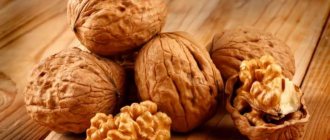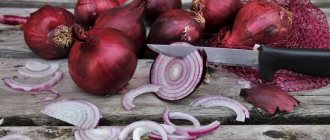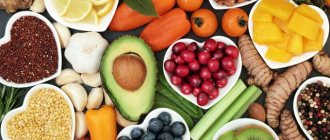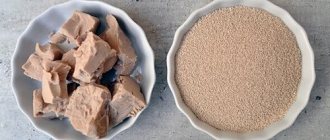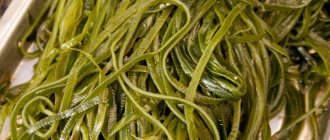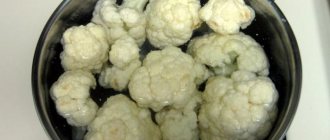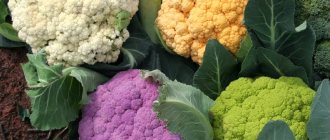White cabbage: benefits and harms, composition, calorie content
The benefits of white cabbage have long been known to everyone, because it is not for nothing that it is considered the queen of the vegetable garden. This root vegetable is mentioned quite often in history. Beautiful and juicy, tasty not only fresh, but also pickled, it is used to prepare a huge number of dishes. Cabbage can be stored all winter without losing its taste or beneficial properties. The queen of the vegetable garden always takes a lot from the earth, so it contains a lot of vitamins and minerals. People actively use cabbage not only for food, but also to treat many diseases.
The benefits of cabbage for women
For the weaker half of humanity, cabbage is useful because it has a positive effect on reproductive function, helps speed up metabolism and eliminates inflammation.
Cabbage has a positive effect not only on the gastrointestinal tract, but also improves appearance. Regular consumption of vegetables improves the structure of skin and hair. It helps get rid of swelling and remove harmful toxins from the body.
The vegetable helps strengthen blood vessels, therefore, it is a preventive measure against the development of varicose veins.
Chemical composition and calorie content
The vegetable is a biennial plant and belongs to the cruciferous family, genus Brassica.
In the first year, the crop produces heads of cabbage, which are used for cooking. As for the second, she releases an arrow with small yellow flowers. After flowering, seeds are formed that can be germinated for further propagation.
Cabbage heads can be oval, flat or round. They consist of succulent leaves, the lower ones are white with a cream tint, and the upper ones are painted in light green tones.
The culture contains a high concentration of microelements and vitamins that are beneficial to the human body, namely:
- calcium, which strengthens teeth and bones;
- potassium, which is necessary for the human body for the full functioning of the heart muscle;
- nicotinic acid, or PP, is responsible for the release of energy during the processing of carbohydrates and fats;
- vitamin K helps to activate tissue regeneration processes, as well as blood clotting;
- B vitamins (B1, B2, B6) are responsible for the health and beauty of hair, nails and skin, and regulate the activity of the nervous system.
The uniqueness of the vegetable lies in its high content of ascorbic acid, which retains its benefits even after long-term storage of the product. For example, after six months of storage, 100 g of cabbage contains at least 50 mg of vitamin C.
An interesting feature is that when cabbage is chopped, ascorbic acid is converted into a bound form - ascorbigen. When interacting with the acidic environment of the stomach, it breaks down into glucobrassicin and vitamin C.
The first segment has the following positive properties on the human body:
- able to stop the growth of papillomas in papillomatosis;
- has an anti-estrogenic effect, which is a prevention against breast cancer;
- suppresses and stops the growth of hormone-dependent cancer cells.
In addition to all of the above, white cabbage contains vitamin U, or S-methylmethionine , which has the following effects on the body.
- acts as an antidepressant, helps improve mood;
- activates regeneration processes, heals ulcers, cuts and wounds;
- takes part in the synthesis of vitamin B4;
- identifies pathogenic and pathogenic microorganisms, removing them from the human body.
Today, scientists continue to actively study the beneficial properties of white, blue and cauliflower to create effective drugs for AIDS and cancer.
The vegetable has very little calorie content. 100 g of fresh product contains only 28 kcal. It contains the most carbohydrates - 4.7 g, proteins - 1.8 g and fats only 0.1 g.
What vitamins are in seaweed?
We recommend reading our other articles
- Clematis Multi Blue
- Rex Rabbits
- Gissar breed of sheep
- How to water grapes correctly
Sea kale is a kelp seaweed suitable for human consumption. This is a very exotic product. But it is very useful, and therefore has recently been popular on sale. Despite the fact that seaweed is usually processed, dried, or other products are added to it before sale, it does not lose its nutritional value.
Important!
The composition of sea kale depends on the light, salinity, and temperature of the sea water in which it grows.
With regular consumption of seaweed, the body is cleansed of radionuclides, cholesterol and other harmful substances. The functioning of the gastrointestinal tract is normalized, the overall weight of the body is reduced. In addition, the immune system is strengthened, brain nutrition is improved, and hormonal levels are normalized.
Vitamins in seaweed
Sea kale can be harmful if consumed for:
- allergies;
- diseases of the endocrine system;
- hemorrhagic diathesis;
- acute gastrointestinal diseases.
100 g of seaweed contains 24.9 kcal. Also included:
- Fats – 0.2 g;
- Proteins – 0.9 g;
- Carbohydrates – 3 g.
The vitamin composition indicates the high benefits of this product.
- Vitamin A – 100 mcg;
- B1 – 0.04 mg;
- B2 – 0.06 mg;
- B6 – 0.02 mg;
- B9 – 2.2 mcg;
- C – 1.9 mg;
- PP – 0.5 mg.
There are a lot of minerals in seaweed, the main ones are listed below.
- Potassium – 942.1 mg;
- Chlorine – 573.8 mg;
- Sodium – 505.5 mg;
- Magnesium 165.1 mg;
- Calcium – 42.4 mg;
- Phosphorus – 53.4 mg;
- Iron – 15.6 mg;
You should also mention such important minerals as iodine, sulfur, cobalt, manganese, copper, molybdenum, zinc, which are also present in the composition, but in smaller quantities.
The benefits and harms of cabbage
The benefits and harms of fresh cabbage for the body are , of course, not the same. There are much more benefits in it, but you should also be aware of the possible harm.
What medicinal and beneficial properties of white cabbage should be noted? Why is she famous all over the world?
For women and men
With regular consumption of the vegetable, it has a beneficial effect on the human body as a whole. A balanced complex of amino acids and vitamins provides the following results:
- Strengthens the body's defenses, enhancing the immune system;
- Significantly reduces the likelihood of getting cancer. In men - the prostate gland, and in women - the mammary gland;
- Normalizes the concentration of cholesterol in the blood;
- Activates blood circulation;
- Enriches the blood composition, significantly increasing hemoglobin;
- Removes excess fluid from the body;
- Normalizes blood sugar levels in type 2 diabetes, reducing the need for sweets;
- Destroys Staphylococcus aureus and tuberculosis bacillus;
- Heals the microflora of the digestive system, stops the processes of decay in the intestines;
- Improves the condition of gums and teeth;
- Helps people get rid of extra pounds.
Benefits for pregnant women and lactation
Pregnant women, as well as those breastfeeding their babies, should definitely include white cabbage in their diet.
The only problem in this case may be flatulence. For this reason, during the period of bearing a child, a woman is recommended to consume the product in fermented form or after heat treatment. The benefits of stewed cabbage for the body are also undeniable. It is recommended to drink fresh cabbage juice every day on an empty stomach, combining it with a small amount of honey. This drink will prepare a woman’s body for the upcoming birth, reduce irritability and tearfulness, and increase stress resistance. Women during lactation are recommended to eat well-beaten leaves before the first juice appears. This will allow excess milk to drain and get rid of the bursting sensations in the chest.
For the child's health
Competent experts recommend introducing white cabbage into complementary foods for babies, starting from five months with artificial feeding, and from six months - for infants.
Regular use of the product will prevent the development of:
For the smallest ones, it is recommended to first boil the raw head, and then use a blender to grind it to a puree, adding a small amount of breast milk or the usual mixture.
After getting used to it, milk and formula can simply be eliminated. Cabbage puree effectively removes poisons and toxins from the body, so this dish is especially useful in treatment, as well as for:
- atopic dermatitis;
- food allergies;
- diathesis.
After one year, the child should be given vegetable stews and soups with cabbage added. From the age of two - salads from fresh vegetables with the addition of oil. This will normalize the functioning of the gastrointestinal tract, provide the necessary load to the chewing muscles, and also improve the health of tooth enamel, helping to prevent caries.
In old age
Due to the content of tartonic acid in white cabbage , the vegetable has a rejuvenating and anti-sclerotic effect. Please note that after heat treatment, tartonic acid decomposes.
In old age, it is recommended to eat cabbage salad daily with the addition of amaranth or grape seed oil. If a person is unable to chew on his own, then he should drink the juice in combination with oil. As a result, vigor and lightness will appear, blood vessels will be cleansed, and cholesterol and stool will be normalized.
Sauerkraut is an excellent preventative against aging. It frees the body from free radicals and promotes the absorption of animal protein.
Harm and contraindications
It is harmful to eat too much cabbage, just as it is generally harmful to overeat.
An excess of kohlrabi in the body will lead to flatulence, nausea, bloating and pain. This is due to the action of fiber in large quantities. This should be remembered by people who want to get rid of extra pounds with the help of cabbage. It is worth noting that the benefits and harms of blue cabbage, as well as other varieties, are of a similar nature. Among the contraindications for use, the following should be noted:
- enterocolitis, pancreatitis;
- increased intestinal motility;
- bleeding in the intestines or stomach;
- exacerbation of intestinal and stomach ulcers (you can make cabbage juice, but you should not drink it without first consulting your doctor).
Features of red cabbage
The red-headed “sister” differs in appearance only in shade (it is red-violet). Regular consumption of this type of cabbage in fresh salads or stews ensures that the body receives many basic nutrients:
- Potassium is a mineral that strengthens the heart and restores blood vessels.
- Folic acid, necessary for normal growth and development.
- B vitamins that restore the functioning of the central nervous system and improve skin condition.
Recommendations for use
To prevent viral and cancer diseases, as well as to replenish the body with ascorbic acid, it is recommended to eat at least 200 g of fresh white cabbage daily. During its preparation you should:
- chop;
- sprinkle with a little table salt;
- leave for at least 20 minutes;
- rub thoroughly with your hands;
- add seasonings if desired (vegetable oil, honey, lemon juice, etc.).
If desired, you can add an apple, beets, bell pepper, carrots, as well as herbs and any nuts to the salad.
In short, there are many recipes and different variations for preparing the salad. If you regularly eat such a salad for breakfast, the body will be freed of toxins, and the problem of dysbacteriosis and constipation will be solved by itself. It is not recommended to eat vegetables for dinner, so as not to overload the stomach before bed.
Vitamin salad from white cabbage
There are many recipes for making cabbage salads. The most useful and popular options among athletes and nutritionists are presented to the reader.
Salad “Charge of vivacity”
The components of this salad saturate the body with vitamins, energy and health. Anyone who wants to have a slim figure, healthy skin and a youthful face should definitely add it to their diet. The salad is easy to prepare and everyone can afford it.
Required Products:
- Half a head of fresh cabbage;
- Several sweet and sour apples;
- One large carrot;
- Mayonnaise, sour cream or vegetable oil for dressing;
- A bunch of fresh parsley;
- Freshly squeezed lemon juice;
- Salt and pepper to taste.
Preparation:
- Wash all vegetables thoroughly.
- Finely chop the cabbage, add salt and squeeze lightly with your hands to soften it and release the juice.
- Peel the carrots and grate on a coarse grater.
- Also grate the apple after the carrots. You can remove the skin from it, but when grated it won’t be tough anyway.
- Add chopped parsley to the vegetables.
- Mix all ingredients well with the chosen dressing and sprinkle with lemon juice. Vitamin salad of vigor is ready!
Read: How many kcal are in white cabbage
Video on the topic:
Salad “Vitamin abundance”
Preparing this salad is not difficult and does not take much time. It can be prepared either immediately before serving or for long-term storage (in a closed glass container it can be stored in the refrigerator for a month). The ingredients in this salad contain a lot of vitamins and contain no harmful fats or weighting agents.
Products for cooking:
- Several bell peppers;
- Two heads of red onion;
- One large carrot;
- Paul – a kilogram of fresh cabbage;
- Sunflower oil and vinegar for dressing.
- Salt, sugar.
Preparation:
- Grind the cabbage into thin shavings.
- Wash the pepper, cut into two parts and remove the core. Cut into thin half rings. We also chop the onion.
- Peel and wash the carrots. You can chop it into long strips or grate it using a Korean grater.
- Combine all vegetables, season with oil, vinegar and salt. You can add a little sugar.
- Place the finished salad in a salad bowl or a clean jar to put in the refrigerator.
Application for weight loss
Given the high content of folic and nicotinic acid with low calorie content, the vegetable is actively used in low-carbohydrate diets , both independently and as a side dish.
The cabbage diet can be done once a week. Throughout the day you should eat a salad of fresh leaves, seasoned with lemon juice. Please note that the salad must be prepared without salt.
During the day you can eat another 100 grams of black bread or two eggs. A glass of tomato juice at night won't hurt. This diet will allow you to lose up to two kilograms during the day.
Cauliflower
The name “cauliflower” for cabbage originated two thousand and a half years ago. Then in the Mediterranean, people developed this variety of vegetable, noting that the head of cabbage consists of small inflorescences.
The nutritional value
One hundred grams of the specified variety of vegetables contains 25 kcal. The main substances contained in it are:
- carbohydrates – 4.97 g;
- proteins – 1.91 g;
- fats – 0.28 g.
Other elements contained in cauliflower include dietary fiber, fiber, acids of organic origin, polyunsaturated acids, starch, and pectins.
Compound
Vitamin substances in the composition of the colored variety of vegetables are represented by elements belonging to the following groups:
| Vitamins per 100 grams of product | Content |
| Vitamin A | 3 mcg |
| Vitamin B1 | 0.1 mg |
| Vitamin B2 | 0.1 mg |
| Vitamin B4 | 45.2 mg |
| Vitamin B5 | 0.9 mg |
| Vitamin B6 | 0.16 mg |
| Vitamin B9 | 23 mcg |
| Vitamin C | 70 mg |
| Vitamin E | 0.2 mg |
| Vitamin H | 1.5 mcg |
| Vitamin K | 16 mcg |
| Vitamin PP | 1 mg |
Mineral components are represented by such elements as:
| Minerals per 100 grams of product | Content |
| Potassium | 299 mg |
| Calcium | 22 mg |
| Magnesium | 15 mg |
| Sodium | 30 mg |
| Phosphorus | 44 mg |
| Iron | 0.42 mg |
| Manganese | 0.155 mg |
| Copper | 39 mcg |
| Selenium | 0.6 mcg |
| Fluorine | 1 mcg |
| Zinc | 0.27 mg |
Benefit
The benefits of eating vegetables are:
- strengthening vascular walls;
- purification of genetic material;
- strengthening bone tissue;
- stimulation of hematopoietic processes;
- improvement of metabolic processes;
- activation of the body's defenses.
Harm and contraindications
Despite the benefits that cauliflower brings to the human body, there are situations when its use is contraindicated. These include:
In addition, people with heart failure should not use it. The presence of kidney stones is also a signal for a ban on eating colored vegetables. In case of a violation of the metabolism of purine substances in the human body, he is also prohibited from using it.
For medicinal purposes
Cabbage leaves are used in folk medicine to treat:
- boils;
- mastitis;
- headaches;
- joint diseases.
To do this, you need to apply a fresh cabbage leaf to the sore spot.
It is recommended to change it every hour. For headaches and migraines, it is useful to apply the leaves to the eyes for a while. The seeds are used to get rid of parasites, in particular worms. To do this, 5 g of seeds must be brewed in a thermos and allowed to brew for three hours. Then strain and drink throughout the day. The duration of the therapeutic course is two weeks.
Cabbage juice is a broad-spectrum medicine. It is recommended to drink it on an empty stomach half an hour before breakfast. In its pure form, it effectively dissolves salt deposits in the spine and joints, and improves tooth enamel.
Use of white cabbage in phytocosmetics
Cabbage leaf has a wound-healing and cleansing effect. For cuts, scratches, and small wounds, wrap the damaged area with a cabbage leaf.
Juice from fresh cabbage or its pulp is applied to the face for 20 minutes to treat rosacea.
Cabbage juice compress for sunburn. Beat 2-3 egg yolks, add 2 tablespoons of vegetable oil and 0.5 cups of cabbage juice, beat again and apply the mixture to the reddened skin, covering with a gauze napkin.
Wrapping tired and cracked feet with cabbage leaves helps relieve fatigue and pain, heal small cracks, and soften the skin.
Cabbage leaves are cut along the veins to release juice and tied to the legs overnight. Gardener's Guide
Plant nurseries Garden supply stores Landscape design studios
Cabbage juice compress to treat severely cracked skin on the feet. 200 g of cabbage leaves are passed through a meat grinder and the juice is squeezed out. Generously moisten gauze napkins in cabbage juice and apply them to the feet, previously steamed in the bath, wrapping them in compress paper. Leave for 15-20 minutes, rinse and dry. Finally, a vegetable wrap is made, for example, from zucchini, which nourishes, moisturizes and treats dry, rough skin. Grate 200 g of zucchini, add 1 teaspoon of sea buckthorn (or corn) oil, apply the mixture to your feet, put on plastic bags, and socks on top. The wrap is left for several hours or overnight. Wash off with warm water, then apply foot cream.
Fresh cabbage juice is a good disinfectant for cracks and sores on the legs and arms.
Cabbage juice serves as a hand protectant before working with soil. It is mixed with vegetable oil or sour cream (5:1) and applied to the hands. This lotion nourishes, moisturizes, protects and heals work-damaged hand skin.
Protective hand lotion . Mix the juice of cabbage, cucumber, zucchini, onions and vegetable oil in equal proportions, apply to the hands 30 minutes before work. This will protect the skin of your hands from drying out and heal small cracks.
Cabbage juice with sour cream (3:1) relieves the unpleasant sensation of stinging from nettles and prevents the formation of bubbles.
Cabbage brine is mixed half and half with sour cream and used to treat irritated skin on the hands.
Cabbage brine is used as a nourishing lotion for hands, moisturizing them and leaving for 10-15 minutes (for scratches and abrasions - no more than 5 minutes), then rinsed with warm water and lubricated with hand cream.
Cabbage nourishing hand mask . 100 g of chopped cabbage leaves are boiled in 200 ml of milk, mashed into a puree, add 2 tsp. olive oil, the same amount of mayonnaise, mix and apply the warm mixture to your hands. Leave for 15-20 minutes, rinse with warm water and lubricate with hand cream.
Sauna balm made from cabbage juice and honey . Before the steam room, a mixture of honey, cabbage and beet juice in a ratio of 5:3:3 is applied to the legs from the feet to the thighs. Steamed legs are massaged from bottom to top, paying special attention to the feet, on which the nerve endings of all systems and organs of our body are located. This procedure has a stimulating effect on the entire body.
Bulletin board
Sale of kittens Sale of puppies Sale of horses
Cosmetics using cabbage and other vegetables
Cabbage juice lotion for dry skin . Dilute 2 teaspoons of honey and 20 g of alcohol into 100 ml of cabbage juice, shake well and leave for two days in a closed dark glass bottle. The lotion is designed to cleanse dry skin before bed.
A decoction of white cabbage leaves for the care of any skin. Boil cabbage leaves in 200 ml of water, leave for 30 minutes, cool and filter. Wipe the skin of the face and neck with the decoction several times a day. It refreshes, nourishes, moisturizes the skin, relieves redness and swelling.
Rub the juice from fresh cabbage onto dry skin instead of washing your face. You can do this 2-3 times within 20 minutes. Due to the content of potassium, calcium, magnesium, sulfur, vitamins B and C, it has a rejuvenating effect, the skin becomes soft, elastic, and youthful.
White cabbage mask . A pulp of cabbage minced through a meat grinder is applied to the face for 20 minutes, rinsing off with water at room temperature. Used to clean, moisturize and nourish dry and normal skin.
Moisturizing massage for dry skin of the face and body. Mix 200 ml of cabbage juice with 20 g of vegetable oil, shake well and rub into the skin 25-30 minutes before taking a shower.
Cabbage and milk mask for dry skin . The cabbage leaf is shredded and boiled in milk, filtered and mashed into a paste. Apply the mask to the face and neck for 20 minutes, rinse with warm milk.
A fresh cabbage mask in the form of gruel or juice for 20 minutes is used to care for sluggish, flabby, wrinkled facial skin.
Mask made from cabbage juice and oatmeal. Recommended 1-2 times a week for the care of sagging, wrinkled skin, as well as freckles and age spots. Take 1 tablespoon of cabbage juice and vegetable oil, add oatmeal to obtain a paste, which is applied to the face for 20 minutes. Wash off with warm water.
Cabbage and cucumber mask. Recommended 1-2 times a week for oily skin care. Prepare a paste (or juice) from equal parts of cabbage and cucumber, apply for 20 minutes, and rinse with cool water.
Sauerkraut mask for oily skin. Once a week, apply chopped sauerkraut (or a napkin moistened with its juice) to your face for 25 minutes, cover it with a napkin and hold it with your hands. Wash off with cool water. The face acquires freshness and a pleasant natural color.
Cabbage-yeast mask for oily skin . Mix 2 teaspoons of cabbage juice with 1 teaspoon of yeast and place in a warm place. The mask will be ready when fermentation begins. The mixture is applied to the facial skin for 20 minutes, washed off with warm, then cold water. The mask cleanses well, nourishes the skin, and tightens enlarged pores.
Cabbage mask for combination skin. 100 g of cabbage leaves are boiled in milk, filtered and passed through a meat grinder. Part of the pulp is mixed with beaten egg white and applied to areas of oily skin, cabbage mass - to areas with dry skin. Leave for 20 minutes, wash off with milk or boiled water.
Mask with cabbage leaves for sensitive skin . Take 2 tablespoons of chamomile, 2 tablespoons of linden blossom, 2 tablespoons of lavender, 1 tablespoon of sage, crush with a pestle in a porcelain mortar and brew with boiling water until a paste forms, which is left to brew in a sealed container for 15-20 minutes. The warm mass is applied to the face and neck, avoiding the area around the eyes. Cover the top of the mask with cabbage leaves (well washed, dried and with the veins broken off). After 20 minutes, everything is removed, the face and neck are rinsed with warm water, then a napkin moistened with cold water is applied.
It is recommended to use these masks daily for 10 days, then every other day until the desired effect is obtained.
Cabbage and honey lip care lotion . Mix fresh cabbage juice and honey in equal quantities. The lips are wiped daily with this composition, which strengthens the red border of the lips, protects it from chapping, and heals small cracks.
Lotion made from cabbage and parsley seeds to nourish hair. Place 1 teaspoon of cabbage and parsley seeds in a thermos and pour 300 ml of boiling water for 6 hours. The infusion is filtered, mixed with 0.5 cups of fresh cabbage juice and rubbed into the scalp 30 minutes before washing. Store the lotion in the refrigerator.
Nourishing hair balm. Chop 50 g of cabbage, nettle and burdock leaves, add 400 ml of milk and boil over low heat until soft. Cool the broth slightly, strain and squeeze, add 20 g of lemon juice and mix well. The balm is applied to the hair, massaging the scalp. Leave for 20-30 minutes and rinse with warm water, after which you wash your hair with egg yolk.
A mixture of juices of white cabbage, spinach and lemon in equal quantities is rubbed into the scalp to improve hair growth. The number of procedures is 10-15.
Hair rinse. 100 g of cabbage and parsley leaves are poured into 0.5 liters of boiling water, boiled for 5 minutes over low heat and left for three hours. The broth is filtered and added to water for rinsing hair, which makes it stronger and more beautiful.
Strengthening balm against hair loss. Prepare a vitamin mixture from spinach and fresh cabbage, passing 200 g of vegetables through a juicer. Add 2 tablespoons of tomato juice and 20 g of vegetable oil (castor oil is possible) to the resulting juice. Rub the balm into the scalp with massaging movements, then use a comb to distribute a thin layer along the entire length of the hair, put on a shower cap and leave for two hours. Wash your hair with shampoo suitable for your hair type.
Nourishing mask against hair loss . Mix 2 tablespoons of cabbage and peach juices, add egg yolk, 20 g of cognac and 20 g of honey. The mask is rubbed into the roots of the hair and distributed over the entire length, put on a shower cap and wrap your head with a towel. After 1.5 hours, wash your hair. Repeat once a week until the desired result occurs. The mask effectively strengthens hair roots, gives hair shine and elasticity.
Read the next part.
Unusual recipes from white cabbage →
E. Marasanova
4896
Tags: white cabbage cabbage cosmetology medicinal plants recipes
Share on social networks:
Add new comment
Useful properties of cabbage:
White cabbage contains a large amount of vitamins and minerals. Vitamin C in the leaves of early varieties contains 20 mg%, in late-ripening varieties – 70 mg%. Cabbage has the ability to retain vitamin C for a long time. The secret of this “longevity” is that vitamin C is found in cabbage not only in its pure form, but also in a chemically bound form – “ascorbigene”. Ascorbigen is the most stable form of vitamin C, and cabbage contains 50 times more of it in this form than, for example, potatoes. In general, there is only 1.5-2 times more vitamin C in cabbage than in potatoes. There is more vitamin C in cabbage than in tangerines and lemons, and 10 times more than in carrots.
In addition to other vitamins, cabbage also contains vitamins B1, B2, PP (albeit in small quantities), as well as folic, pantothenic acids, potassium salts, calcium, phosphorus, etc. White cabbage contains almost the entire set of vitamins necessary for humans.
Cabbage is a source of minerals, mainly potassium, calcium, phosphorus, and sulfur. The predominant microelements are aluminum, zinc, iron, and manganese.
Scientists have discovered that a distinctive feature of white cabbage is vitamin U - methylmethionine, which can cure gastric and duodenal ulcers, ulcerative colitis, gastritis and intestinal lethargy.
The pharmacological effects of cabbage are very diverse. Cabbage stimulates metabolic processes, has anti-inflammatory and analgesic effects (calorizer). It is included in the therapeutic diet for atherosclerosis (the dietary fiber contained in cabbage helps eliminate cholesterol, and vitamins C and P, which it is rich in, strengthen blood vessels and have an anti-sclerotic effect), coronary heart disease, gout (cabbage practically does not contain purines, which cause gout). deposits), cholelithiasis (cabbage dietary fiber binds and prevents the absorption of cholesterol and bile acids in the intestines, from the excess of which deposits are formed - atherosclerotic plaques on the walls of blood vessels and stones in the gall bladder), heart and kidney diseases (potassium salts promote fluid excretion), gastritis with low acidity and constipation.
The benefits of sauerkraut
Daily use of this product normalizes the activity of the gastrointestinal tract and nervous system, improves heart function, cleanses blood vessels, and stimulates the immune system. Due to the content of lactic acid bacteria, sauerkraut has a beneficial effect on the intestinal microflora, relieves bloating, and helps treat colitis.
In therapeutic and dietary nutrition, the dish is widely used for:
- prevention of cancer and cardiovascular diseases thanks to antioxidants and probiotics: the former prevent cancer, the latter reduce cholesterol levels;
- increasing hemoglobin levels due to the presence of iron;
- treatment of vitamin deficiency thanks to a rich set of vitamins.
In cosmetology it is used for:
- rejuvenation thanks to carotene and vitamin A, acting as antioxidants;
- improvement of teeth and nails: this is facilitated by calcium, magnesium, zinc and B vitamins.
Numerous studies on volunteers have shown excellent results in losing weight and preventing the risk of type II diabetes, since sauerkraut prevents the absorption of fats by intestinal cells. With long-term use (from 12 to 24 weeks), the subjects experienced persistent weight loss while maintaining performance, cheerfulness and appetite.
For women
Benefits of sauerkraut for women:
- vitamin A maintains skin tone, stimulates the development of epidermal cells, relieves swelling;
- ascorbic acid makes wrinkles less noticeable and participates in the formation of collagen;
- folic acid reduces the manifestations of toxicosis during pregnancy, promotes the formation of fetal tissue;
- due to its low calorie content, the product is effective for weight loss;
- fiber cleanses the intestines of toxins, probiotics normalize microflora;
- zinc and magnesium alleviate the condition during menopause, the former is involved in the functioning of the endocrine system.
Brine masks rejuvenate the skin, get rid of acne, and fade freckles and age spots.
For men
The benefits of sauerkraut are evident for the body not only of women, but also of men. Regular snack consumption:
- strengthens the immune system thanks to vitamin C and probiotics;
- increases libido and improves potency, since zinc and vitamin A stimulate the production of the male sex hormone testosterone.
Brine has choleretic and detoxifying properties, so it is effective for hangovers.
Contraindications:
We have already figured out why cabbage is useful. But can it do any harm?
Compared to the beneficial properties, there is little harm; there are some contraindications. Thus, overeating the product in its raw form can lead to nausea, bloating, and heaviness in the stomach.
It is not recommended to use the product if you have high acidity, enteritis, colitis, myocardial infarction, or diarrhea.
You cannot constantly eat raw stalks, since they accumulate harmful substances that the vegetable absorbed during growth (copper salts, nitrates, cadmium).
It is not recommended to eat cabbage if you have thyroid diseases! Cabbage helps cure gastric and duodenal ulcers, but in severely advanced cases and severe exacerbations, cabbage can already cause harm. Increased acidity of gastric juice also does not like cabbage, but in this case it is not contraindicated, but should be consumed within reasonable limits and preferably not raw. Sauerkraut can also be harmful to the kidneys and liver due to its high salt content, and can also harm hypertensive patients. If you really want sauerkraut, we advise you to wash it well from the brine or initially ferment it with a minimum of salt.
When choosing cabbage, the head should be dense and the cut should be white. If the cut is dark brown, it means that it has already been stale and has lost a significant part of its beneficial properties. You should not buy vegetables with stains, deep damage or foreign odors. Fresh cabbage should not have limp leaves, it is usually bright green in color and heavy in weight.
Benefits of cabbage:
For women:
Women who care about their figure need to pay special attention to this vegetable. After all, it contains tartronic acid, which prevents the carbohydrates we consume from turning into fatty deposits. But for many, it’s so hard without sweets. By the way, tartronic acid is susceptible to heat treatment, but it remains perfectly preserved in fermented water.
Cabbage also contains folic acid, which is so necessary for us women. Cell renewal and oxygen saturation cannot occur without it. And it is indispensable for the skin and hair. Probably everyone knows about the need for folic acid during pregnancy. But it is necessary for both teenage girls (corrects puberty) and older women.
What does cabbage cure?
How to treat gastritis with cabbage?
One of the most proven methods is to treat gastritis with cabbage juice. Most people underestimate this vegetable, but in vain. After all, white cabbage is a real chest of vitamins. In particular, it contains a unique vitamin U (methylmethionine), especially necessary for a person with gastritis or ulcers, as well as PP, which tidies up the functioning of the gastrointestinal tract.
We can say that cabbage juice is considered somewhat exotic, and sauerkraut is a completely familiar dish, which, however, should not be consumed during the phase of exacerbation of the disease. And in the subsiding phase of the disease, sauerkraut for gastritis contributes to:
- improving motor skills;
- eliminating constipation;
- improving microflora in the intestines;
- increasing immunity;
- eliminating inflammation in the mucous membrane.
And sauerkraut for gastritis with high acidity can be consumed limitedly, but only during the period of subsidence of the disease. It is best to abandon it in this form when the acid level increases, so as not to cause complications of gastritis and stomach ulcers.
The main product in the treatment of this disease (especially when the acidity level decreases) can be stewed cabbage. During stewing of vegetables, useful elements are preserved, which help improve the functioning of the digestive tract and reduce the load on the stomach tissue. Stewed cabbage for gastritis has the following effects:
- eliminates inflammation of the mucous membrane;
- accelerates regenerative processes;
- improves digestion;
- perfectly satisfies hunger while following a strict diet;
- reduces pain.
How to eat cabbage with pancreatitis?
White cabbage in the acute phase of pancreatitis:
The inflamed pancreas quickly and violently reacts to any dietary deviations with painful attacks, increased vomiting, profuse diarrhea, renewed fever, bloating and some other serious symptoms. Dishes with white cabbage can provoke or intensify all these unpleasant signs of an acute process in the pancreas. This negative impact is due to the content in it:
- Essential oils (it is their presence that explains the pungent taste of raw cabbage);
- Coarse fiber (fibers are visible even to the naked eye in cabbage), the amount of which is 2 g per 100 g of product.
White cabbage in remission phase:
After inflammation subsides or completely resolves, the diet of patients with pancreatitis expands significantly. The introduction of white cabbage begins with its inclusion in vegetable soups. If the patient does not experience any adverse changes in well-being after such a lunch, then other boiled, stewed and baked dishes with cabbage (casseroles, cabbage rolls, stews, cutlets, rolls, etc.) are added to the menu. If stable, satisfactory health is maintained, then fresh and non-acidic sauerkraut is included in the diet. However, in this form it can serve as an impetus for a new exacerbation, so you should eat it very carefully and in limited quantities.
Dietary recommendations for patients with pancreatogenic diabetes (caused by pancreatitis) are no different in this case. After all, white cabbage contains little sucrose and starch, so it changes blood sugar levels little.
Great video about cabbage! Worth a look!
Vitamins and minerals in 100 grams of cabbage
A distinctive feature is methylmethionine in the composition. This amino acid helps prevent the development of atherosclerosis, reducing cholesterol levels in the blood, and stimulates the production of B4 - choline, a vitamin that accelerates the regeneration of the mucous membrane lining the digestive tract and organs.
The predominant vitamins in cabbage per 100 g:
- Vitamin C (ascorbic acid) - 60 mg - has an antioxidant effect and stimulates the production of hormones responsible for a good mood, has an adsorbing effect, accelerates the absorption of iron from foods;
- Vitamin B4 - 10.7 mg - normalizes the functions of the central and peripheral nervous systems and stabilizes carbohydrate metabolism;
- Vitamin B3 (nicotinic acid) - 0.9 mg - increases the defenses of the human body.
But these are not all the vitamins that cabbage contains. Fresh cabbage contains tocopherol, niacin, riboflafin, thiamine, pyridoxine and phylloquinone. The last nutrient is responsible for blood clotting.
To understand how healthy white cabbage is, you should look at its mineral composition.
The predominant macroelements (per 100 g) are:
- potassium - 300 mg - stabilizes acid-base and water-electrolyte balance, normalizes heart contractions;
- silicon - 53 mg - stimulates the regeneration of bone and cartilage tissue, has an adsorption effect;
- calcium - 48 mg - mineralizes the musculoskeletal system and teeth;
- sulfur and chlorine - 37 mg each - thanks to this substance, the body is protected from the aggressive effects of radiation and ultraviolet radiation, receives bile during meals, and chlorine retains fluid, maintaining skin elasticity;
- phosphorus - 31 mg - distributes energy throughout the body, providing energy throughout the day.
Also sufficient amounts of magnesium and sodium.
The human body also needs microelements no less. Per 100 g predominate:
- manganese - 0.17 mg - improves the properties of synovial fluid and promotes the restoration of cartilage tissue;
- iron - 0.6 mg - prevents the development of anemia and supports the life cycle of red blood cells;
- zinc - 0.4 mg - if this substance is not enough, age-related changes quickly develop.
The composition also contains other trace elements (boron, iodine, cobalt, fluorine, chromium) - 13 items in total.
You can count how many essential and non-essential amino acids there are. The first - 12, with a predominance of arginine and leucine, the second - 8, most of all glutamic and aspartic acids. Glutamic acid has a restorative effect and helps to return to normal after physical activity that causes muscle microtrauma, and aspartic acid normalizes nerve impulse conduction.
But white cabbage occupies one of the leading roles in the human body not only because of its vitamin and mineral properties. It is also tasty; it can be consumed fresh, salted, pickled, or after heat treatment.
How to treat bruises, swelling and bruises with cabbage?
The properties of cabbage leaves to heal wounds and stop bleeding are used for bruises, especially on the arms and legs. Swelling and pain decrease, hematomas resolve, and the consequences of bruises are not so serious.
You can apply a clean whole cabbage leaf to the bruised area, or you can squeeze the juice out of it, moisten a piece of cotton or linen cloth with it and apply it to the damaged area, applying any securing bandage. This lotion quickly relieves pain and restores damaged tissue.
How to apply cabbage leaves to sore spots?
First of all, I would like to say that it is best to take cabbage leaves for medicinal purposes from a head of cabbage grown on your own plot or purchased at the market from farmers and individuals. Leaves for compresses must be thoroughly rinsed with running water and dried.
If the leaves are applied to wounds or other damaged skin surfaces, they should be doused with boiling water before use. You can prepare several leaves in this way, put them in a plastic bag, place them in the refrigerator and use them as needed.
Before use, the leaves need to be kept at room temperature for some time, do not apply them when cooled.
Before use, the leaves must be rinsed, after removing the hardest parts of the veins. This is done so that the leaf releases juice, thereby ensuring that all the medicinal properties of the cabbage leaf are released. You need to knead its outer side, which is applied to the sore spot, for which you can use a wooden hammer, a rolling pin for rolling out dough, or the blunt side of a knife. You can even cut the leaves slightly, but not all the way through, so that the juice does not leak out, but only moisturizes the leaves.
The thickness of the compress depends on the size of the painful area and the size and thickness of the leaves themselves. Sometimes one or two leaves are enough, and sometimes you may need a stack of leaves that overlap each other with a slight overlap.
Cabbage leaves should fit tightly to the sore spot and be secured with a bandage.
How to choose.
For those who do not have their own garden or cottage, they have to purchase the product in stores or markets. So, let's look at what factors play an important role:
- The cabbage must be ripe, otherwise it will not be crispy, not juicy and not healthy at all.
To begin, take the fruit in your hands and squeeze lightly. A ripe fruit does not change its shape and does not leave dents.
- The leaves of a ripe product should be moderately soft, but at the same time elastic.
- Perfectly moisturizes facial skin.
- There should not be any damage. The surface should be smooth, but not glossy.
- The leaves at the base of the fruit should be thin.
There should not be a massive stalk. These signs indicate that the cabbage was fertilized with artificial fertilizers and nitrates.
- When you get home, before preparing any dish, be sure to remove the top leaves from the fruit.
They contain a huge number of microbes that cannot be washed off with water.
Harm and contraindications
Despite all the medicinal properties, in some situations, white cabbage can cause harm to humans. Contraindications include:
- Chronic diseases of the gastrointestinal tract in the acute stage. Cabbage contains a number of substances that cause irritation of the mucous membranes, which can aggravate gastritis or peptic ulcers of the stomach and duodenum.
- Increased sensitivity of the body. If the immune system is sensitized to any cabbage vegetable crops, eating cabbage is strictly prohibited due to the high risk of developing allergic reactions.
Cabbage is allowed and even recommended for use by women during pregnancy (in the absence of the contraindications described above). The plant contains a number of vitamins and minerals that are necessary for the adequate formation of all organs of the fetus. For example, folic acid is responsible for the formation of the nervous system and is a means of preventing neural tube defects.
Brief answers to questions
Below are answers to the most frequently asked questions regarding the use of cabbage;
- Which variety is the healthiest? Red and purple cabbage contain significantly more antioxidant substances than the white cabbage variety. The concentration of vitamins (except A and C) is almost the same. The composition is practically no different from Chinese cabbage.
- Is it possible to eat the stalk (head of cabbage)? It is in the central part of the cabbage that chemicals from fertilizers, pesticides, and atmospheric air are concentrated. Only with full confidence in favorable growing conditions can cabbage stalks be eaten.
- Is heat treatment necessary? Any heat treatment leads to a decrease in the concentration of biologically active substances, therefore, it is recommended to give preference to raw cabbage. Boiled, stewed and steamed cabbage is also acceptable, but it is better to avoid fried cabbage.
- Is it possible for children? Yes! Cabbage is rich in vitamins and minerals necessary for the growth of a child’s body. You can include the product in the diet of children from 8 months of age (in puree form).
Sources:
https://vitaminki.guru/produktyi/belokochannaya-kapusta https://prokalorijnost.ru/belokochannaya-kapusta-polza-i-vred-dlya-organizma-cheloveka https://wikifood.online/food/belokochannaya-kapusta- polza.html


